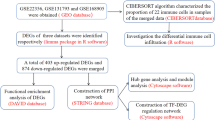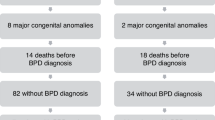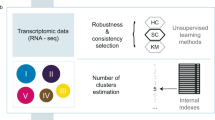Abstract
Background
Insulin-like growth factors (IGFs), and their binding proteins (IGFBPs), play a significant role in cardiovascular function and may influence the pathobiology of PAH. We determined the diagnostic and prognostic value of IGF1 and IGFBP2 in pediatric PAH.
Methods
Serum was analyzed by ELISA for IGF1 and IGFBP2 in pediatric PAH subjects from the NHLBI PAH Biobank (PAHB, n = 175) and a cohort of asthmatic subjects (n = 46, age 0–21 years) as a chronic pediatric pulmonary disease control. Biomarkers were analyzed with demographic and clinical variables for PAH severity.
Results
Serum IGF1 was significantly lower in PAH compared to controls, while IGFBP2 was elevated in PAH subjects compared to controls. In the PAHB, IGF1 was negatively associated with mPAP and PVR, while IGFBP2 was positively associated with PVR and negatively associated with cardiac output and 6-min walk distance. Higher IGFBP2 levels were associated with use of prostacyclin therapy. IGFBP2 was associated with death, transplant, or palliative shunt with a Cox proportional hazard ratio of 8.8 (p < 0.001) but not IGF1 (p = 0.13).
Conclusions
Circulating IGFBP2 is a novel marker for pediatric PAH, which is associated with worse functional status, and survival. IGF axis dysregulation may be an important mechanistic target in pediatric pulmonary arterial hypertension.
Impact
-
Pediatric pulmonary hypertension is a severe disease, with poorly understood pathobiology.
-
There are few studies looking at the pathobiology of pulmonary hypertension only in children.
-
The IGF axis is dysregulated in pediatric pulmonary arterial hypertension.
-
IGF axis dysregulation, with increased IGFBP2, is associated with worse clinical outcomes in pediatric pulmonary artery hypertension.
-
IGF axis dysregulation gives new insight into the disease process and may be a mechanistic or therapeutic target.
Similar content being viewed by others
Log in or create a free account to read this content
Gain free access to this article, as well as selected content from this journal and more on nature.com
or
References
Frank, B. S. & Ivy, D. D. Diagnosis, evaluation and treatment of pulmonary arterial hypertension in children. Children 5, 44 (2018).
Galie, N., McLaughlin, V. V., Rubin, L. J. & Simonneau, G. An overview of the 6th World Symposium on Pulmonary Hypertension. Eur. Respir. J. 53, 1802148 (2019).
Tuder, R. M. et al. Relevant issues in the pathology and pathobiology of pulmonary hypertension. J. Am. Coll. Cardiol. 62(25 Suppl), D4–D12 (2013).
Tuder, R. M. & Voelkel, N. F. Angiogenesis and pulmonary hypertension: a unique process in a unique disease. Antioxid. Redox Signal. 4, 833–843 (2002).
Archer, S. L., Fang, Y. H., Ryan, J. J. & Piao, L. Metabolism and bioenergetics in the right ventricle and pulmonary vasculature in pulmonary hypertension. Pulm. Circ. 3, 144–152 (2013).
Delafontaine, P. Insulin-like growth factor I and its binding proteins in the cardiovascular system. Cardiovasc. Res. 30, 825–834 (1995).
Forbes, B. E., McCarthy, P. & Norton, R. S. Insulin-like growth factor binding proteins: a structural perspective. Front. Endocrinol. 3, 38 (2012).
Delafontaine, P. Insulin-like growth factor I and its binding proteins in the cardiovascular system. Cardiovasc. Res. 30, 825–834 (1995).
Yau, S. W., Azar, W. J., Sabin, M. A., Werther, G. A. & Russo, V. C. IGFBP-2 - taking the lead in growth, metabolism and cancer. J. Cell Commun. Signal. 9, 125–142 (2015).
Besnard, V. et al. Distinct patterns of insulin-like growth factor binding protein (IGFBP)-2 and IGFBP3 expression in oxidant exposed lung epithelial cells. Biochim. Biophys. Acta 1538, 47–58 (2001).
Guiot, J., Bondue, B., Henket, M., Corhay, J. L. & Louis, R. Raised serum levels of IGFBP-1 and IGFBP-2 in idiopathic pulmonary fibrosis. BMC Pulm. Med. 16, 86 (2016).
Berry, M. et al. Proteomics analysis reveals IGFBP2 as a candidate diagnostic biomarker for heart failure. IJC Metab. Endocr. 6, 5–12 (2015).
Hemnes, A. R. et al. Human PAH is characterized by a pattern of lipid-related insulin resistance. JCI Insight 4, e123611 (2019).
National Asthma Education and Prevention Program & Third Expert Panel on the Diagnosis and Management of Asthma. Expert Panel Report 3: Guidelines for the Diagnosis and Management of Asthma (National Heart Lung and Blood Institute, Bethesda, MD, 2007).
Insulin-Like Growth Factor 1 (IGF1), LC-MS and Insulin-Like Growth Factor-Binding Protein 3 (IGFBP3) Growth Panel, Serum. Edited by Mayo Clinic Laboratories, https://www.mayocliniclabs.com/test-catalog/Clinical+and+Interpretive/36365.
Delafontaine, P., Song, Y. H. & Li, Y. Expression, regulation, and function of IGF-1, IGF-1R, and IGF-1 binding proteins in blood vessels. Arterioscler. Thromb. Vasc. Biol. 24, 435–444 (2003).
Wood, A. W., Schlueter, P. J. & Duan, C. Targeted knockdown of insulin-like growth factor binding protein-2 disrupts cardiovascular development in zebrafish embryos. Mol. Endocrinol. 19, 1024–1034 (2005).
Ren, J., Samson, W. K. & Sowers, J. R. Insulin-like growth factor I as a cardiac hormone: physiological and pathophysiological implications in heart disease. J. Mol. Cell. Cardiol. 31, 2049–2061 (1999).
Motiwala, S. R. et al. Measurement of novel biomarkers to predict chronic heart failure outcomes and left ventricular remodeling. J. Cardiovasc. Transl. Res. 7, 250–261 (2014).
Pickard, A. & McCance, D. J. IGF-binding protein 2 - oncogene or tumor suppressor? Front. Endocrinol. 6, 25 (2015).
Azar, W. J. et al. IGFBP-2 enhances VEGF gene promoter activity and consequent promotion of angiogenesis by neuroblastoma cells. Endocrinology 152, 3332–3342 (2011).
McMullen, J. R. Role of insulin-like growth factor 1 and phosphoinositide 3-kinase in a setting of heart disease. Clin. Exp. Pharmacol. Physiol. 35, 349–354 (2008).
Lin, K. W., Liao, A. & Qutub, A. A. Simulation predicts IGFBP2-HIF1alpha interaction drives glioblastoma growth. PLoS Comput. Biol. 11, e1004169 (2015).
Acknowledgements
This study was supported by the National Institutes of Health/National Heart, Lung, and Blood Institute awards R01HL135114 and R01 HL150070 (to A.D.E., M.N., J.Y., R.D., D.V., W.C.N., D.I., and E.D.A.), R24 HL105333 (to W.C.N., M.W.P., D.I., and E.D.A.). Serum/tissue samples were provided by PHBI under the Pulmonary Hypertension Breakthrough Initiative (PHBI). Funding for the PHBI is provided under an NHLBI R24 grant, #R24HL123767 (to A.D.E.). M.G. was supported by the Pediatric Scientist Development Program. The Pediatric Scientist Development Program is supported by Award Number K12-HD000850 from the Eunice Kennedy Shriver National Institute of Child Health and Human Development. M.N was supported by The Matthew and Michael Wojciechowski Pulmonary Hypertension Pediatric Proof-of-Concept Grant (Dr. Robyn J. Barst Pediatric PH Research and Mentoring Fund Grant).
Author information
Authors and Affiliations
Contributions
M.G., J.Y., M.N., and A.D.E. planned the project, analyzed the data, and wrote the manuscript; M.G., S.B., and J.Y. performed the experiments and interpreted the results; M.G., R.D., and J.Y. performed statistical analysis; M.N., M.W., E.C.M., T.G., R.D., D.I., E.D.A., W.C.N., M.W.P., K.L., E.B.R., R.H., D.Y., and A.D.E. recruited subjects and performed research; all authors reviewed, revised, and approved the manuscript for submission.
Corresponding author
Ethics declarations
Competing interests
The authors declare no competing interests.
Ethical approval
All samples and clinical data have been collected with informed consent and assent where appropriate. All cohorts have been approved by the Institutional Review Board at their respective institution and by the Johns Hopkins University Institutional Review Board.
Additional information
Publisher’s note Springer Nature remains neutral with regard to jurisdictional claims in published maps and institutional affiliations.
Supplementary information
Rights and permissions
About this article
Cite this article
Griffiths, M., Yang, J., Nies, M. et al. Pediatric pulmonary hypertension: insulin-like growth factor-binding protein 2 is a novel marker associated with disease severity and survival. Pediatr Res 88, 850–856 (2020). https://doi.org/10.1038/s41390-020-01113-x
Received:
Revised:
Accepted:
Published:
Issue date:
DOI: https://doi.org/10.1038/s41390-020-01113-x
This article is cited by
-
Targeted proteomic profiling of transcatheter edge-to-edge repair failure in patients with mitral regurgitation and heart failure
Clinical Research in Cardiology (2025)
-
“An unprecedented occurrence: a case report of pulmonary hypertension manifestation in Donohue syndrome”
BMC Pediatrics (2024)
-
Identification and interaction analysis of molecular markers in myocardial infarction by bioinformatics and next-generation sequencing data analysis
Egyptian Journal of Medical Human Genetics (2024)



